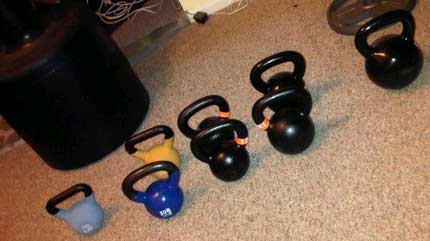No matter how many years I've attended, or how easily I slip into the familiar, beloved rhythms of the days, the gifts of pilgrimage are always new and surprising. Case in point:
Rick Wigton and I had talked a couple of times since the 2012 pilgrimage about kettlebell training, which is an important part of my life (when I'm not retreating, of course). He had recently purchased a kettlebell and a training video, and when he and Melissa arrived at pilgrimage, he asked me to help him with his technique--there were some things he wasn't understanding from the video, and both of them wanted to make sure he wasn't doing something that would end up injuring him.
I'm always very happy to teach (and prevent injury!) so on my next trip home, I loaded up about 125 pounds of kettlebells into the back seat of my longsuffering SUV and hauled them up the mountain. We cleared out the side patio of Stillpoint, laid down yoga mats, and got to work.
 The whole happy family of kettlebells . . . think "solid iron cannonballs with handles"
The whole happy family of kettlebells . . . think "solid iron cannonballs with handles"
As often happens at pilgrimage, we started making connections between the work we were doing, and the ongoing conversations about spirituality happening in the sessions. Just that day, in fact, Stefan had asked us about our daily practices of meditation and mindfulness, and as I listened to the wisdom of the group, I recognized that kettlebell training employed many of the techniques suggested, and offered many of the same benefits--expressed in terms that integrated the physical and the spiritual.
Just as background, "hardstyle" kettlebell training originated in the 70s to support hardstyle martial arts (as practiced by Soviet special forces in hand-to-hand combat--yikes!). Many mindful practices that come to us from Asian cultures, then, are reflected in the physical discipline:
The kettlebell training community refers to what we do as "practice", in the same manner as yoga or meditation. It is mindful work, not just a "workout". We never quite arrive, but continually work towards refinement of our practice, with strength and increasing levels of fitness developing as a result of that disciplined practice.
Because it is mindful work, we train in silence (other than the necessary encouragement and coaching cues provided by the instructor) to facilitate careful attention and mindful awareness of the weight in motion, and the body as it moves and stabilizes that weight. Noticeably absent (thankfully!) are the deafening, pounding rock or rap soundtracks of most modern gyms. We listen. We pay attention. Our fearfully-and-wonderfully-made bodies deserve no less; the iron demands no less.
We train barefoot! We practice a barefoot connection to the earth, called "rooting" or "grounding", to establish and maintain stability in the body as the heavy weight moves around or past the axis of the spine; and to push against the earth under the heavy weight, transmitting strength into the body, quite literally, from the ground up. (We also have a saying in the kettlebell community: quick feet are happy feet. Yes.)
Awareness of and mindful, deliberate connection between breath and movement are part of the practice as well. A short, sharp indrawn breath, taken and held at the initiation of the movement, stabilizes the body's core; and a forceful exhalation of the breath at the movement's completion helps to direct the force of the body to the kettlebell.
Awareness of the importance of connecting, integrating the body is essential to this practice. Far from the isolation exercises (curls! crunches! feel the burn!) of popular gym culture, this is full-body work. The legs push against the earth, transmitting great force through the stabilized spine, torso, and shoulders into the arms to move the heavy iron bell. The spiritual truth demonstrated by this physical discipline--various parts of the body working together to generate and focus a great and common strength to accomplish a mission--should not be lost on those in the church, the Body of Christ.
Finally, my experience of the wider kettlebell training community is that of radical welcome, hospitality, and encouragement. All who wish to participate have a place at the table: training events are typically filled with people of all ages, national origins, levels of fitness and skill, and life experiences. We begin where we are--with full acceptance and no judgment--and work together to improve our practice, become stronger and more aware, more effective. We never stop learning, refining, growing. We pay careful attention to each other. We take responsibility for each other.
Hmm. Sounds like another dear community I know and love.
Talking together about and thinking through the surprising connections between these two disciplines and communities, which might seem to have nothing to do with each other, has made my pilgrimage experience this year even richer. Each time I return, I have the sense that my fragmented self is being gathered more and more into some kind of lovely unity, an integrity that I know will never be complete this side of heaven--and that's OK. It gives me something to look forward to: what will next year bring?!
Tracy Seffers